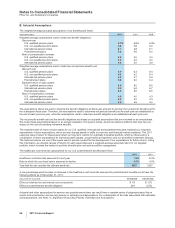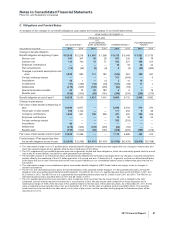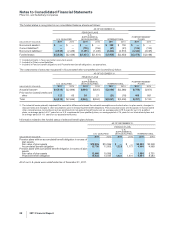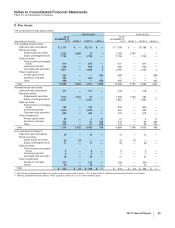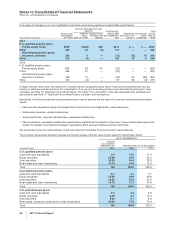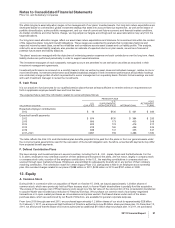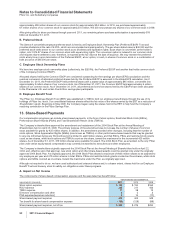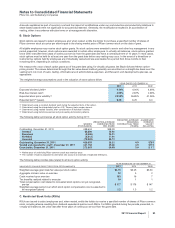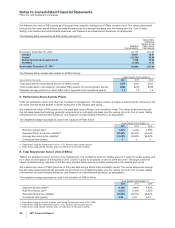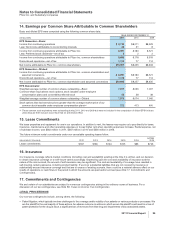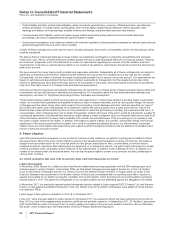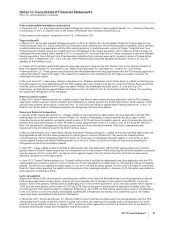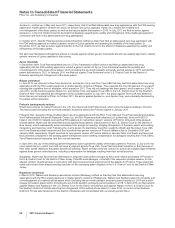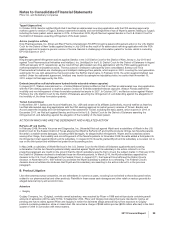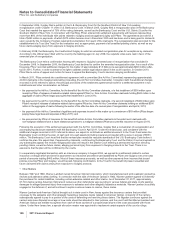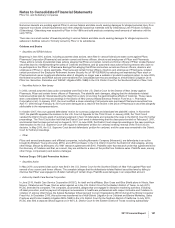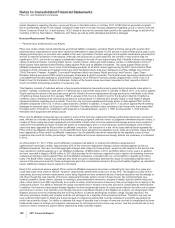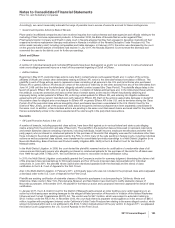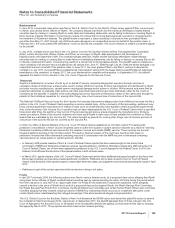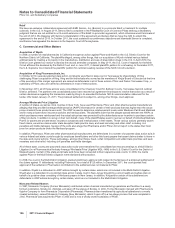Pfizer 2011 Annual Report Download - page 97
Download and view the complete annual report
Please find page 97 of the 2011 Pfizer annual report below. You can navigate through the pages in the report by either clicking on the pages listed below, or by using the keyword search tool below to find specific information within the annual report.
Notes to Consolidated Financial Statements
Pfizer Inc. and Subsidiary Companies
•Product liability and other product-related litigation, which can include personal injury, consumer, off-label promotion, securities-law,
antitrust and breach of contract claims, among others, often involves highly complex issues relating to medical causation, label
warnings and reliance on those warnings, scientific evidence and findings, actual provable injury and other matters.
•Commercial and other litigation, which can include merger-related and product-pricing claims and environmental claims and
proceedings, can involve complexities that will vary from matter to matter.
•Government investigations, which often are related to the extensive regulation of pharmaceutical companies by national, state and local
government agencies in the U.S. and in other countries.
Certain of these contingencies could result in losses, including damages, fines and/or civil penalties, and/or criminal charges, which
could be substantial.
We believe that our claims and defenses in these matters are substantial, but litigation is inherently unpredictable and excessive
verdicts do occur. We do not believe that any of these matters will have a material adverse effect on our financial position. However,
we could incur judgments, enter into settlements or revise our expectations regarding the outcome of certain matters, and such
developments could have a material adverse effect on our results of operations or cash flows in the period in which the amounts are
paid and/or accrued.
We have accrued for losses that are both probable and reasonably estimable. Substantially all of these contingencies are subject to
significant uncertainties and, therefore, determining the likelihood of a loss and/or the measurement of any loss can be complex.
Consequently, we are unable to estimate the range of reasonably possible loss in excess of amounts accrued. Our assessments are
based on estimates and assumptions that have been deemed reasonable by management, but the assessment process relies
heavily on estimates and assumptions that may prove to be incomplete or inaccurate, and unanticipated events and circumstances
may occur that might cause us to change those estimates and assumptions.
Amounts recorded for legal and environmental contingencies can result from a complex series of judgments about future events and
uncertainties and can rely heavily on estimates and assumptions. For information about the risks associated with estimates and
assumptions, see Note 1C. Significant Accounting Policies: Estimates and Assumptions.
The principal pending matters to which we are a party are discussed below. In determining whether a pending matter is a principal
matter, we consider both quantitative and qualitative factors in order to assess materiality, such as, among other things, the amount
of damages and the nature of any other relief sought in the proceeding, if such damages and other relief are specified; our view of
the merits of the claims and of the strength of our defenses; whether the action purports to be a class action and our view of the
likelihood that a class will be certified by the court; the jurisdiction in which the proceeding is pending; any experience that we or, to
our knowledge, other companies have had in similar proceedings; whether disclosure of the action would be important to a reader of
our financial statements, including whether disclosure might change a reader’s judgment about our financial statements in light of all
of the information about the Company that is available to the reader; the potential impact of the proceeding on our reputation; and
the extent of public interest in the matter. In addition, with respect to patent matters, we consider, among other things, the financial
significance of the product protected by the patent. As a result of considering qualitative factors in our determination of principal
matters, there are some matters discussed below with respect to which management believes that the likelihood of possible loss in
excess of amounts accrued is remote.
A. Patent Litigation
Like other pharmaceutical companies, we are involved in numerous suits relating to our patents, including but not limited to those
discussed below. Most of the suits involve claims by generic drug manufacturers that patents covering our products, processes or
dosage forms are invalid and/or do not cover the product of the generic manufacturer. Also, counterclaims, as well as various
independent actions, have been filed claiming that our assertions of, or attempts to enforce, our patent rights with respect to certain
products constitute unfair competition and/or violations of the antitrust laws. In addition to the challenges to the U.S. patents on a
number of our products that are discussed below, we note that the patent rights to certain of our products are being challenged in
various other countries.
ACTIONS IN WHICH WE ARE THE PLAINTIFF AND CERTAIN RELATED ACTIONS
Lipitor (atorvastatin)
In November 2008, Apotex Inc. notified us that it had filed an abbreviated new drug application with the FDA seeking approval to
market a generic version of Lipitor. In December 2008, we filed patent-infringement suits against Apotex Inc. in the U.S. District
Court for the District of Delaware and the U.S. District Court for the Northern District of Illinois. In August 2009, our action in the
District of Delaware was transferred to the Northern District of Illinois and consolidated with our pending action there. Apotex Inc.
asserts the invalidity of our patent covering the crystalline form of atorvastatin, which (including the six-month pediatric exclusivity
period) expires in 2017. We assert the infringement of our crystalline patent and are defending against the allegations of invalidity.
In November 2011, our previously reported patent-infringement actions related to Lipitor against KUDCO Ireland, Ltd. and Kremers
Urban LLC and against Aurobindo Pharma Ltd. in the U.S. District Court for the District of Delaware were settled on terms that are
not material to Pfizer.
Lipitor began to face generic competition in the U.S. in November 2011.
In the U.K., while the basic patent for Lipitor expired in November 2011, the exclusivity period has been extended by six months to
May 2012 by virtue of the supplementary protection certificate and pediatric extension. In September 2011, Dr. Reddy’s Laboratories
(UK) Limited filed an action in the High Court of Justice seeking revocation of the six-month pediatric extension. We are defending
this action, which is based upon the interpretation of the EU Pediatric Medicines Regulation.
96 2011 Financial Report


